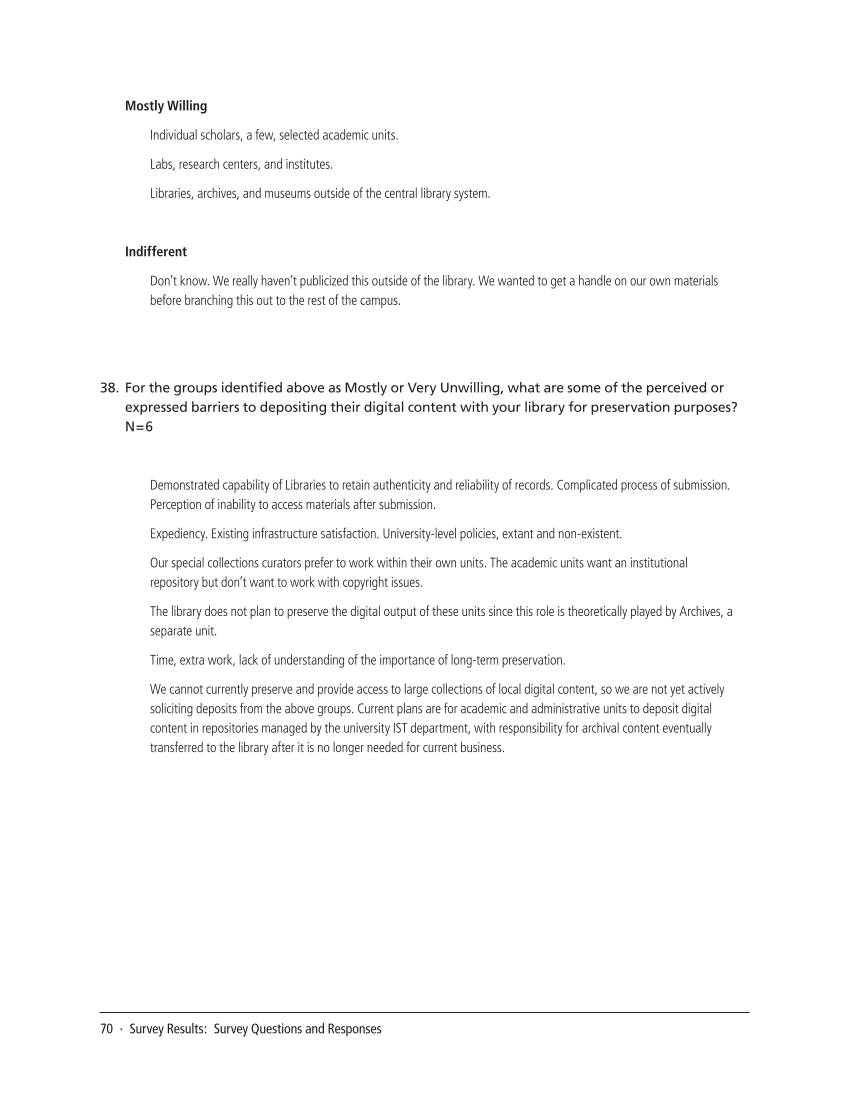70 · Survey Results: Survey Questions and Responses
Mostly Willing
Individual scholars, a few, selected academic units.
Labs, research centers, and institutes.
Libraries, archives, and museums outside of the central library system.
Indifferent
Don’t know. We really haven’t publicized this outside of the library. We wanted to get a handle on our own materials
before branching this out to the rest of the campus.
38. For the groups identified above as Mostly or Very Unwilling, what are some of the perceived or
expressed barriers to depositing their digital content with your library for preservation purposes?
N=6
Demonstrated capability of Libraries to retain authenticity and reliability of records. Complicated process of submission.
Perception of inability to access materials after submission.
Expediency. Existing infrastructure satisfaction. University-level policies, extant and non-existent.
Our special collections curators prefer to work within their own units. The academic units want an institutional
repository but don’t want to work with copyright issues.
The library does not plan to preserve the digital output of these units since this role is theoretically played by Archives, a
separate unit.
Time, extra work, lack of understanding of the importance of long-term preservation.
We cannot currently preserve and provide access to large collections of local digital content, so we are not yet actively
soliciting deposits from the above groups. Current plans are for academic and administrative units to deposit digital
content in repositories managed by the university IST department, with responsibility for archival content eventually
transferred to the library after it is no longer needed for current business.
Mostly Willing
Individual scholars, a few, selected academic units.
Labs, research centers, and institutes.
Libraries, archives, and museums outside of the central library system.
Indifferent
Don’t know. We really haven’t publicized this outside of the library. We wanted to get a handle on our own materials
before branching this out to the rest of the campus.
38. For the groups identified above as Mostly or Very Unwilling, what are some of the perceived or
expressed barriers to depositing their digital content with your library for preservation purposes?
N=6
Demonstrated capability of Libraries to retain authenticity and reliability of records. Complicated process of submission.
Perception of inability to access materials after submission.
Expediency. Existing infrastructure satisfaction. University-level policies, extant and non-existent.
Our special collections curators prefer to work within their own units. The academic units want an institutional
repository but don’t want to work with copyright issues.
The library does not plan to preserve the digital output of these units since this role is theoretically played by Archives, a
separate unit.
Time, extra work, lack of understanding of the importance of long-term preservation.
We cannot currently preserve and provide access to large collections of local digital content, so we are not yet actively
soliciting deposits from the above groups. Current plans are for academic and administrative units to deposit digital
content in repositories managed by the university IST department, with responsibility for archival content eventually
transferred to the library after it is no longer needed for current business.






























































































































































